Most order statuses are applied as a result of store user or customer action, but some must be manually changed. Order statuses can help you decide what actions need to be taken for a particular order, such as whether the order need to be packaged or shipped.
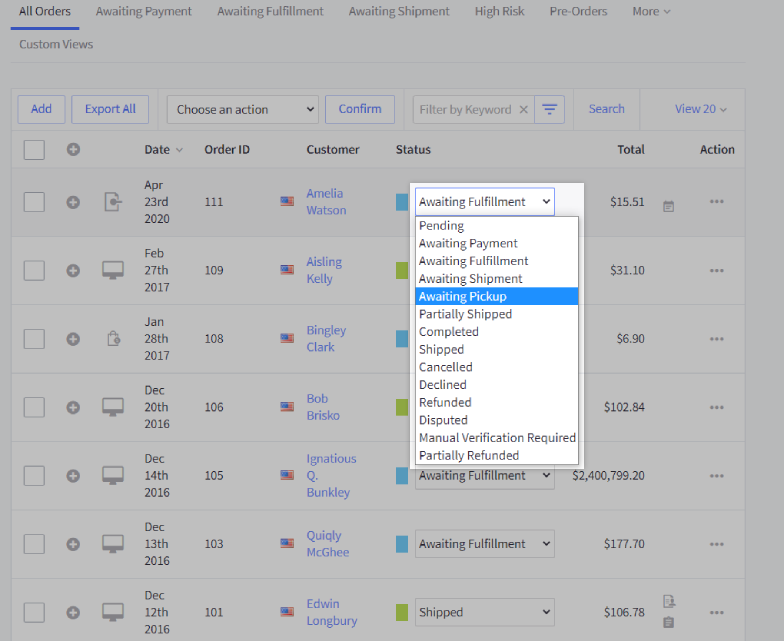
The default order view enables you to quickly and easily find orders you're looking for based on a specific order status, such as Awaiting Shipment, Awaiting Payment, and more. This helps you to fulfill orders and communicate with your customers in a timely manner, leading to higher satisfaction and return business.
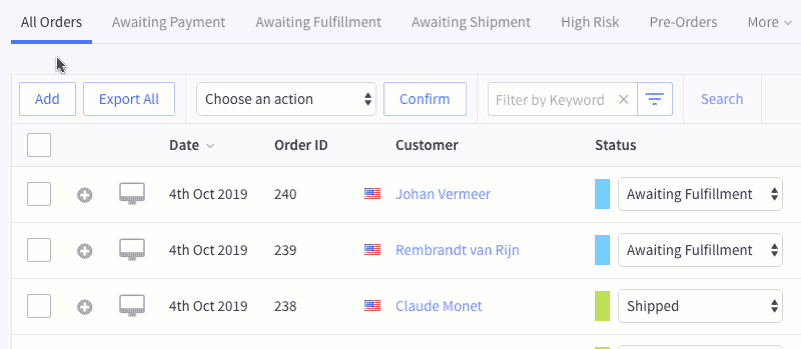
Below we'll explain the various statuses an order can have, changing an order's status, and how they can be used in your fulfillment process.
Order Statuses (List)
Here is the list of the built-in order statuses that can be applied to orders. All new orders that have been paid for will have a status of "Awaiting Fulfillment" (physical products) or "Completed" (digital products), but this can vary based on the payment gateway and method used.
Pre-orders (which can also be used for back orders) use the same statuses listed here to represent if the order is pending, awaiting payment, or awaiting fulfillment. You can access your pre-orders from the View Orders screen.
- Pending — Customer started the checkout process but did not complete it. Incomplete orders are assigned a "Pending" status and can be found under the More tab in the View Orders screen.
- Awaiting Payment — Customer has completed the checkout process, but payment has yet to be confirmed. Authorize only transactions that are not yet captured have this status.
- Awaiting Fulfillment — Customer has completed the checkout process and payment has been confirmed.
- Awaiting Shipment — Order has been pulled and packaged and is awaiting collection from a shipping provider.
- Awaiting Pickup — Order has been packaged and is awaiting customer pickup from a seller-specified location.
- Partially Shipped — Only some items in the order have been shipped.
- Completed — Order has been shipped/picked up, and receipt is confirmed; client has paid for their digital product, and their file(s) are available for download.
- Shipped — Order has been shipped, but receipt has not been confirmed; seller has used the Ship Items action. A listing of all orders with a "Shipped" status can be found under the More tab of the View Orders screen.
- Cancelled — Seller has cancelled an order, due to a stock inconsistency or other reasons. Stock levels will automatically update depending on your Inventory Settings. Cancelling an order will not refund the order. This status is triggered automatically when an order using an authorize-only payment gateway is voided in the control panel before capturing payment.
- Declined — Seller has marked the order as declined.
- Refunded — Seller has used the Refund action to refund the whole order. A listing of all orders with a "Refunded" status can be found under the More tab of the View Orders screen.
- Disputed — Customer has initiated a dispute resolution process for the PayPal transaction that paid for the order or the seller has marked the order as a fraudulent order.
- Manual Verification Required — Order on hold while some aspect, such as tax-exempt documentation, is manually confirmed. Orders with this status must be updated manually. Capturing funds or other order actions will not automatically update the status of an order marked Manual Verification Required.
- Partially Refunded — Seller has partially refunded the order.
Certain order statuses are associated with a paid or unpaid status. If you are using an automatic tax provider, this may affect tax document submission such as moving an order from a paid status into an unpaid status.
An order status is considered paid when the status is any of the following:
- Captured
- Awaiting Fulfillment
- Awaiting Pickup
- Awaiting Shipment
- Completed
- Refunded
- Partially Refunded
- Partially Shipped
- Shipped
An order status is considered unpaid when the status is any of the following:
- Pending
- Awaiting Payment
- Declined
See our Tax Overview article for more information on how these order statuses affect tax document submission.
Changing an Order Status
Some order statuses are applied when a particular control panel action is performed, while others need to be manually applied. For example, shipping items will change an order's status to Shipped, whereas a Cancelled or Declined order status has to be manually applied.
To manually change an order status, select it from the Order Status drop-down on Orders › View.
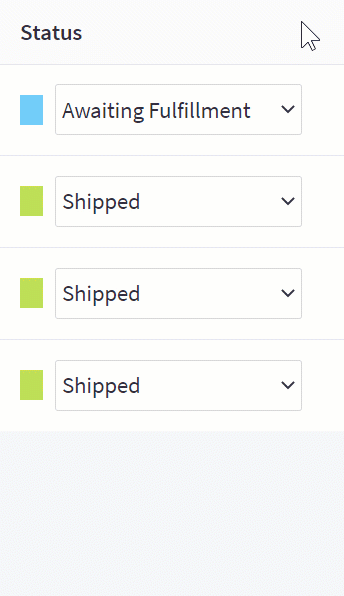
When an order's status has been changed, an email can be sent to the customer automatically to notify them. You can select which statuses trigger these emails under Settings › Order notifications.
Order Status Workflow
Below is an example of an order status workflow to provide insight into how statuses may be used in the fulfillment process. Every business is unique, and the best practices for one may not be ideal for another. Experiment with your workflow and see what best works for you.
1. You receive notification of a new order.
2. Checking your orders screen, you see you have a new order with a status of Awaiting Fulfillment, which indicates the order is paid and ready for you to pull.
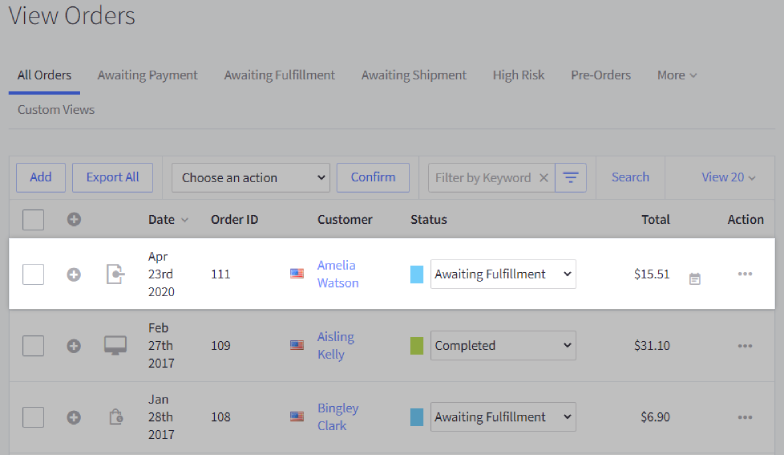
3. You package the order and purchase the appropriate shipping label. You take the package to a shipping provider or schedule a pickup. In either case, you manually update the status to Awaiting Shipment, which indicates the order is ready to leave your point of origin.
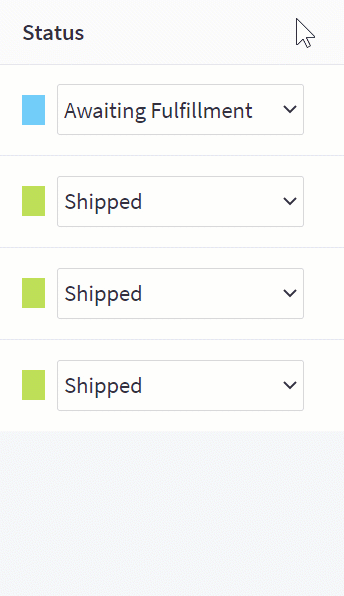
4. Once in the hands of the shipping provider, you go to Orders › View and use the Ship Items action. You can select Ship Items from the action menu, or click the button in the image below while viewing the order details. This updates the order status to Shipped, indicating it has left its point of origin.
5. As a best practice, you will want to confirm receipt by the customer via the tracking number or other methods. Once this is confirmed, you can manually update the order status to Complete. Your workflow may differ depending on your business type and the number of orders your store receives.
Status Change Notifications
You can select which order statuses trigger an email notification to your customers by editing your order notification settings. This is in addition to the Order email (also known as the Invoice email), which is sent automatically. You can customize the email templates for both the order confirmation and status update messages from Settings › Order Notifications in the control panel.
Order status notifications are universal and apply to all customers. For example, you can't specify that a particular customer group doesn't get a particular status notification. Note that customized order statuses will be reflected in email notifications sent from your store.
Customizing an Order Status Label
You can customize the order status labels to something more specific to your business. For example, you could update the Awaiting Shipment status (which represents that an order has been pulled and packaged, and is awaiting collection from a shipping provider) to Package ready to be picked up by FedEx. This will not give it any additional functionality, but can be used to provide more specifics for your customers or fulfillment team.
How will changing a label affect my analytics? Analytics will continue to utilize the original order statuses as it did before the name change. For example, renaming "Completed" to "Not completed" would still count as "Completed" for analytics.
To rename an order status, go to Settings › Order Statuses, then click Edit. The fields will become editable text fields, and you can customize your Order Status labels up to 200 characters in length.
To return to the original status name, click the ellipses and select Restore to Default.
Once you are satisfied with your changes, click Save. Your changes will be updated throughout the control panel. For example, on the View Orders screen, you will see that the filters and statuses have been updated to your new values.
If your label is longer than 30 characters, it will be trimmed in the control panel but will show as full length to your customers.
FAQ
What are incomplete orders?
An incomplete order happens when a shopper reached the payment page but did not complete the transaction. Incomplete orders can be the result of:
- a failed payment attempt such as a declined credit card
- the shopper left the payment page before completing the order
- they never completed the transaction by returning from a hosted payment gateway
Incomplete orders are often mistaken as abandoned carts, but they are not the same. An abandoned cart is a cart that has items in it, but the visitor left without attempting payment. To learn how to recover these carts, see Using the Abandoned Cart Saver.
Incomplete orders have an order status of Pending and can be found under the More tab on the View Orders screen.
Right now, all new orders default to Awaiting Payment. Can I change that to something else?
No. The default order status cannot be changed at this time.
Can I create/delete order statuses?
No, but you can rename them.
Why do stock levels decrease when I change an order to Completed status?
Changing an order's status to Shipped or Completed can affect product stock level if you are tracking stock. You can change this in your store's inventory settings.


